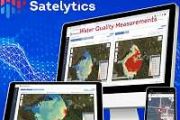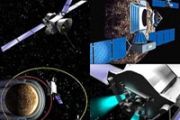
Copernical Team
New maps help developers plan lunar road trip for VIPER's Artemis Mission
 As any seasoned road-tripper knows, to get the most out of an adventure, a good map helps. It's no different for NASA's first lunar robotic rover planned for delivery to the Moon in late 2023 to search for ice and other resources on and below the lunar surface. The Volatiles Investigating Polar Exploration Rover, or VIPER, is part of the agency's Artemis program. Without a Moon travel guide, VIP
As any seasoned road-tripper knows, to get the most out of an adventure, a good map helps. It's no different for NASA's first lunar robotic rover planned for delivery to the Moon in late 2023 to search for ice and other resources on and below the lunar surface. The Volatiles Investigating Polar Exploration Rover, or VIPER, is part of the agency's Artemis program. Without a Moon travel guide, VIP India's ISRO tests high-powered rocket engine for country's first manned mission
 The Indian Space Research Organisation (ISRO) has planned to send two uncrewed flights to test end-to-end capacity for the country's first manned mission, Gaganyaan. As the first flight deadline is December, the space agency is racing against time to launch the mission as the COVID-19 lockdown has drastically affected their schedule.
The Indian Space Research Organisation (ISRO) has succes
The Indian Space Research Organisation (ISRO) has planned to send two uncrewed flights to test end-to-end capacity for the country's first manned mission, Gaganyaan. As the first flight deadline is December, the space agency is racing against time to launch the mission as the COVID-19 lockdown has drastically affected their schedule.
The Indian Space Research Organisation (ISRO) has succes Musk's Starship launch tower in Texas might be demolished
 The massive launch tower for the Starship spacecraft at a SpaceX site in Texas may be demolished based on the results of an ongoing environmental review, CNBC reported, citing the Federal Aviation Administration (FAA).
"The company is building the tower at its own risk", a FAA official told CNBC.
The source in the agency also noted that the review might recommend demolishing the laun
The massive launch tower for the Starship spacecraft at a SpaceX site in Texas may be demolished based on the results of an ongoing environmental review, CNBC reported, citing the Federal Aviation Administration (FAA).
"The company is building the tower at its own risk", a FAA official told CNBC.
The source in the agency also noted that the review might recommend demolishing the laun Lockheed Martin opens new spacecraft facility in Florida
 Lockheed Martin opened a new spacecraft facility Thursday to help build NASA's Orion lunar capsules near Kennedy Space Center in Florida.
Lockheed Martin says the new STAR Center in Titusville is now a "digitally transformed factory of the future" that will help produce spacecraft to take astronauts to the moon. STAR stands for Spacecraft Test, Assembly and Resource.
"This repres
Lockheed Martin opened a new spacecraft facility Thursday to help build NASA's Orion lunar capsules near Kennedy Space Center in Florida.
Lockheed Martin says the new STAR Center in Titusville is now a "digitally transformed factory of the future" that will help produce spacecraft to take astronauts to the moon. STAR stands for Spacecraft Test, Assembly and Resource.
"This repres China's Commercial Space Industry
 Richard Branson won the billionaire space race this week when he boarded his Virgin Galactic spacecraft and became the first "space tourist" for a few minutes. He got there ahead of Amazon founder Jeff Bezos who is to take off in his Blue Origin rocket next week.
Of course, American firms aren't the only ones heading into space. In recent months, China's national space program has landed r
Richard Branson won the billionaire space race this week when he boarded his Virgin Galactic spacecraft and became the first "space tourist" for a few minutes. He got there ahead of Amazon founder Jeff Bezos who is to take off in his Blue Origin rocket next week.
Of course, American firms aren't the only ones heading into space. In recent months, China's national space program has landed r Germany becomes latest NATO member to establish military space command
 During the Cold War, the US tested a slew of anti-satellite weapons, including detonating a nuclear weapon in space, which damaged a Soviet satellite. However, only recently has Washington worried that space was becoming militarized - now that other nations are developing similar capabilities.
On Tuesday, Germany became the latest NATO power to inaugurate a separate space command, followin
During the Cold War, the US tested a slew of anti-satellite weapons, including detonating a nuclear weapon in space, which damaged a Soviet satellite. However, only recently has Washington worried that space was becoming militarized - now that other nations are developing similar capabilities.
On Tuesday, Germany became the latest NATO power to inaugurate a separate space command, followin NASA identifies computer problem on Hubble, says fix will take a few days
 Engineers at NASA have identified the potential cause of a payload computer problem that has sidelined the Hubble Space Telescope for more than a month.
The agency said Thursday it would start a process to switch to a backup system, and that the telescope could be back to normal operations within a few days.
The payload computer, part of Hubble's Science Instrument Command and Da
Engineers at NASA have identified the potential cause of a payload computer problem that has sidelined the Hubble Space Telescope for more than a month.
The agency said Thursday it would start a process to switch to a backup system, and that the telescope could be back to normal operations within a few days.
The payload computer, part of Hubble's Science Instrument Command and Da Juno tunes into Jovian radio triggered by Jupiter's volcanic moon Io
 By listening to the rain of electrons flowing onto Jupiter from its intensely volcanic moon Io, researchers using NASA's Juno spacecraft have found what triggers the powerful radio emissions within the monster planet's gigantic magnetic field. The new result sheds light on the behavior of the enormous magnetic fields generated by gas-giant planets like Jupiter.
Jupiter has the largest, mos
By listening to the rain of electrons flowing onto Jupiter from its intensely volcanic moon Io, researchers using NASA's Juno spacecraft have found what triggers the powerful radio emissions within the monster planet's gigantic magnetic field. The new result sheds light on the behavior of the enormous magnetic fields generated by gas-giant planets like Jupiter.
Jupiter has the largest, mos Zhurong rover visits parachute and backshell
 The China National Space Administration published on Thursday three pictures taken recently by its Zhurong Mars rover that showed the parachute and bowl-shaped back shell used in the rover's landing.
The pictures - one color and two black-and-white - were shot by Zhurong's navigation camera on Monday as the rover was traveling southward for its scientific exploration, the administration sa
The China National Space Administration published on Thursday three pictures taken recently by its Zhurong Mars rover that showed the parachute and bowl-shaped back shell used in the rover's landing.
The pictures - one color and two black-and-white - were shot by Zhurong's navigation camera on Monday as the rover was traveling southward for its scientific exploration, the administration sa NASA studies bigger, better Mars helicopter
 As the Mars helicopter Ingenuity breaks interplanetary records and captures the public's attention, NASA is quietly researching a bigger, better Mars chopper to navigate the Red Planet's rough terrain.
The next aircraft sent to Mars has no budget, no confirmed design and no launch date, but researchers at NASA and various universities have studied possible destinations for such a missio
As the Mars helicopter Ingenuity breaks interplanetary records and captures the public's attention, NASA is quietly researching a bigger, better Mars chopper to navigate the Red Planet's rough terrain.
The next aircraft sent to Mars has no budget, no confirmed design and no launch date, but researchers at NASA and various universities have studied possible destinations for such a missio 
































